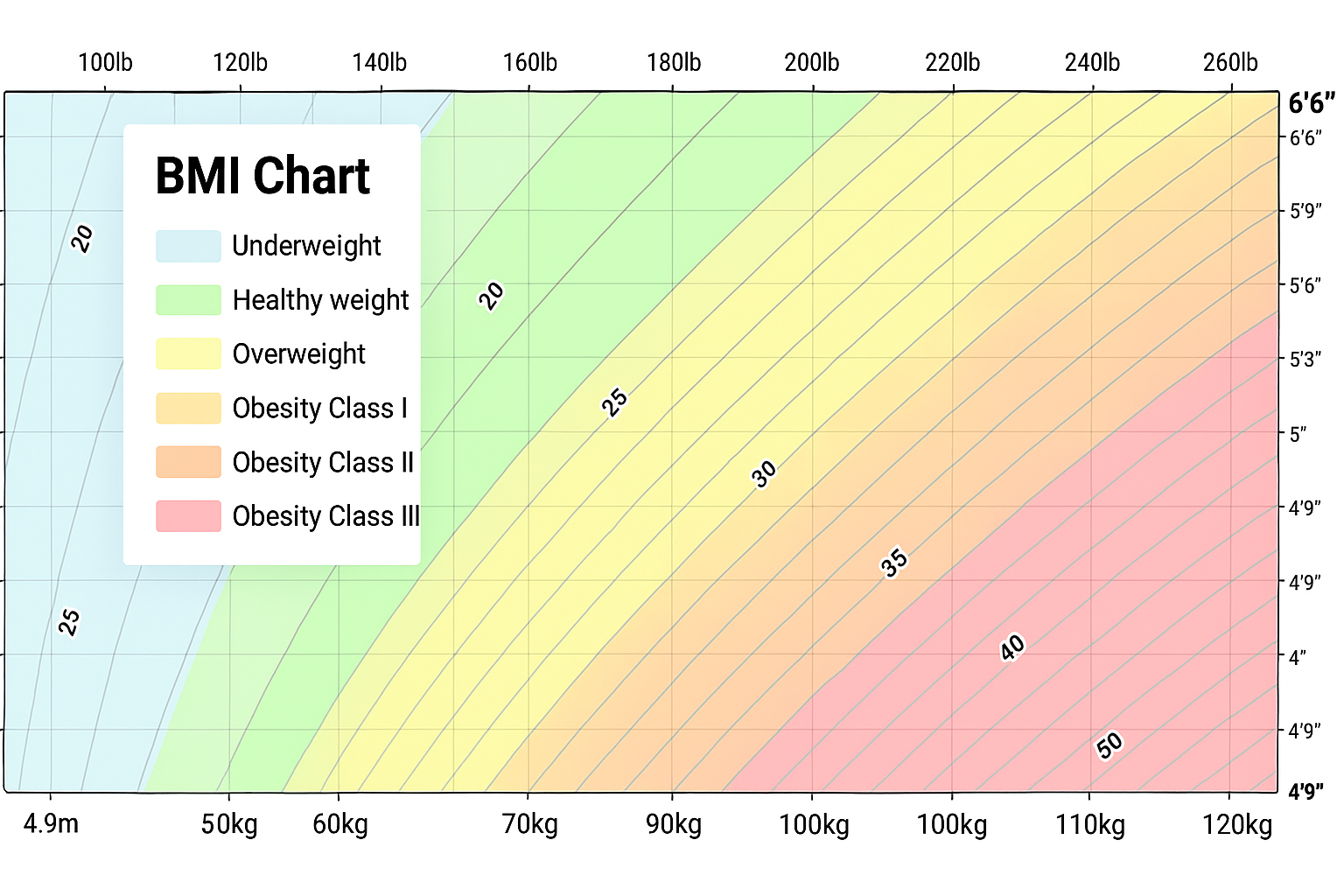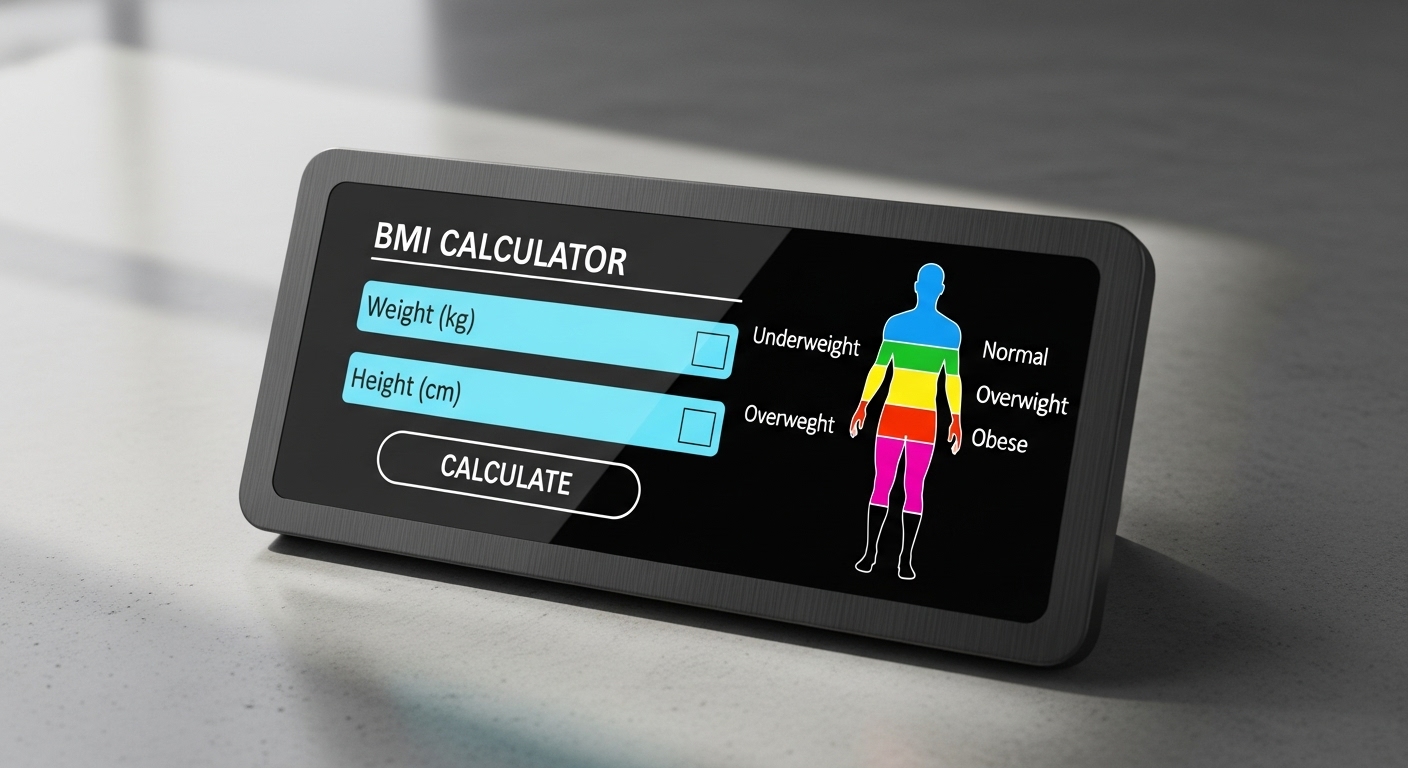BMI Calculator & Basal Metabolic Rate Calculator Over 40
What is BMI?
BMI (Body Mass Index) is a reliable screening number derived from your height and weight. It shows if you are at a healthy weight. It also tells if you are underweight, overweight, or obese. It’s not a diagnostic tool by itself. For a more comprehensive health picture, consider combining it with waist measurements and clinical checks.
If you want to check your BMI now, you can check it at our Free BMI Calculator.
How to calculate BMI (U.S. units)
BMI = 703 × weight (lbs) ÷ height (in)²
Quick example:
If someone weighs 180 lb and is 5 ft 8 in (68 in tall), the calculation is:
703 × 180 ÷ 68² = 703 × 180 ÷ 4,624 ≈ 27.4
(This falls in the “Overweight” category.)

Adult BMI Categories in the U.S.
| BMI (kg/m²) | Category |
|---|---|
| Below 18.5 | Underweight |
| 18.5–24.9 | Healthy weight |
| 25.0–29.9 | Overweight |
| 30.0–34.9 | Obesity (Class I) |
| 35.0–39.9 | Obesity (Class II) |
| 40.0 and above | Obesity (Class III) |
Note for parents and teens: For under-20s, BMI must be interpreted via age- and sex-specific percentiles, adult cutoffs.
Step-by-Step: How to Calculate Your BMI
- Measure height without shoes.
- Record weight using a reliable scale.
- Use the formula above-no algebra needed.
- Round your answer to one decimal for better readability.
What Does Your BMI Calculator Tell You?
Your BMI category and BMI Calculator suggest certain risk levels:
- Underweight: Possible nutrient deficiencies or underlying conditions.
- Maintain a healthy weight by adopting a lifestyle with balanced nutrition and regular physical activity.
- Overweight/Obesity: Higher risk of type 2 diabetes, high blood pressure, heart issues, sleep apnea, and related conditions.
BMI is your starting point-it doesn’t diagnose. Always discuss it along with lab tests, fitness, family history, and waist measurements to get a complete picture.
Waist Circumference: An Important Companion Metric
Abdominal fat poses added health risks-even if your BMI looks okay.
- Risk thresholds:
- 35 in for women
- 40 in for men
- How to measure: Wrap the tape measure just above your hip bones, parallel to the floor. Exhale and then record the measurement.
A normal BMI paired with an elevated waist size still increases health risks. Use both numbers to get the clearest reading of your risk level.

BMI Limitations to Keep in Mind
- May overestimate fat in muscular people, like athletes
- Can mislabel older adults with low muscle mass
- Doesn’t account for fat distribution or ethnic body composition differences
Use BMI responsibly-add context through body measurements, labs, and clinical evaluation.
What is a good basal metabolic rate range?
A good basal metabolic rate (BMR) range depends on your age, sex, weight, height, and body makeup. So, there is no one “ideal” number for everyone.
For most adults:
- Women: BMR typically ranges from about 1,200 to 1,600 calories per day
- Men: BMR typically ranges from about 1,600 to 2,000 calories per day
These numbers show how many calories your body burns while at rest. This helps keep important functions like breathing, circulation, and cell repair going. Athletes or people with more muscle may have a higher BMR. Smaller or older people may have a lower BMR.
To get the best results, calculate your BMR. You can use a formula like the Harris-Benedict or a body composition test.
What to Do Next, Based on Your BMI Calculator
- Underweight (< 18.5): Investigate underlying causes, ensure balanced nutrition, and perhaps consult a dietitian.
- Healthy (18.5–24.9): Maintain with strength training, varied activity, and balanced meals.
- Overweight (25–29.9): Measure waist, check metabolic labs, increase protein intake, and get consistent exercise.
- Obesity (≥ 30): Consider comprehensive support-nutrition planning, behavioral coaching, supervised activity, or medications. Your healthcare provider can advise the best path for you.
FAQs About the BMI Calculator
How do I calculate my BMI?
To calculate your BMI in U.S. units, multiply your weight in pounds by 703, then divide by your height in inches squared. In metric units, divide your weight in kilograms by your height in meters squared. Example: For someone who is 150 lb and 65 in tall, BMI = 703 × 150 ÷ (65 × 65) ≈ 25.0.
What is the normal BMI?
For adults, a normal BMI is 18.5 to 24.9. This range is linked to the lowest risk of weight-related health problems. For those under 20, BMI should be assessed using age- and sex-specific growth charts.
What is the BMI of 70 kg and 170 cm?
BMI = 70 ÷ (1.70 × 1.70) = 70 ÷ 2.89 ≈ 24.2. This falls in the normal BMI range for adults.
What is BMI meant for?
BMI (Body Mass Index) is a screening tool used to estimate whether your weight is in a healthy range for your height. It helps identify underweight, overweight, and obesity categories, which can be linked to health risks. BMI is not a diagnostic tool and should be combined with waist measurements, lab tests, and a full health assessment.
How to BMI calculator in kg?
To calculate BMI in kg, divide your weight in kilograms by your height in meters squared (BMI = kg/m²).
Step-by-step:
Measure your weight in kilograms (kg).
Measure your height in meters (m).
Square your height (multiply height by itself).
Divide your weight by your squared height.
Example:
Weight = 70 kg
Height = 1.75 m
Height² = 1.75 × 1.75 = 3.06
BMI = 70 ÷ 3.06 = 22.9 (Healthy range)
BMI Categories (WHO Standards):
Underweight: Below 18.5
Normal weight: 18.5 – 24.9
Overweight: 25 – 29.9
Obesity: 30 and above







